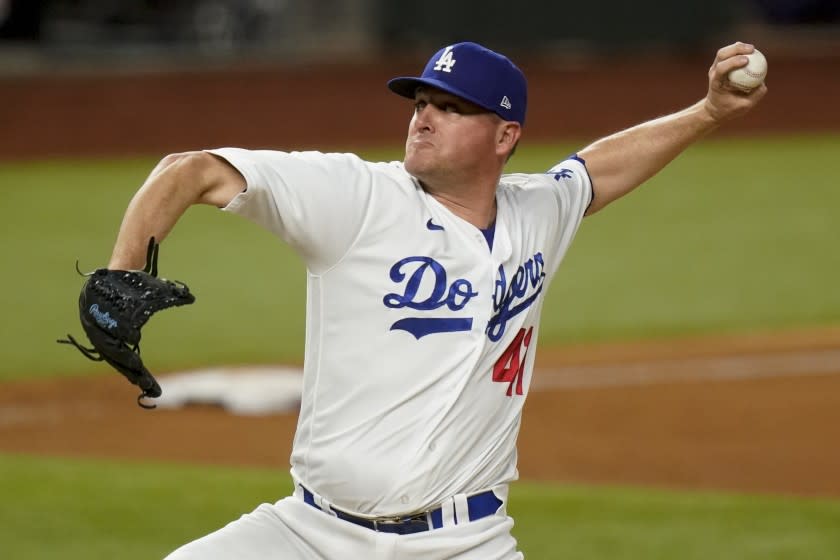Does free-agent reliever Jake McGee fit into the Dodgers' plans for 2021?

The fourth story of a series looking at the status of Dodgers free agents heading into the 2021 season.
JAKE McGEE
CASE FOR THE DODGERS KEEPING HIM: A full season of Dodgers analytics might complete his career revival, at a low free-agent cost.
CASE AGAINST: Victor Gonzalez emerged in September and, especially, October. He might be better than McGee, and he’ll get minimum wages.
BEST OTHER FITS: Phillies, Nationals, Marlins.
Every time he spoke with reporters over a video call this season, Jake McGee struck a grateful, optimistic tone.
He was thankful the Dodgers signed him in late July, days after he was released by the Colorado Rockies following four pedestrian seasons that made his early-career success with the Tampa Bay Rays feel like a distant dream.
He gained confidence from renewed effectiveness with his four-seam fastball, which fooled hitters with increased velocity and movement that he hadn’t generated in years.
He felt valuable too, becoming one of the key left-handers in the Dodgers' bullpen, with a 2.66 ERA (his lowest since 2015) and a career-best 14.6 strikeouts-per-nine-innings.
“I thought there was a lot of upside to come over here,” he said during the regular season. “Just really comfortable and throwing my fastball a lot.”
At 34 and entering free agency this winter, it’s likely that McGee’s Dodgers tenure will end having lasted just the one pandemic-shortened season. However, his MLB career looks far from over. And when he arrived in Los Angeles in July, there was no guarantee that would be the case.
Having signed a lucrative three-year extension with the Rockies after the 2017 season, McGee posted a 5.54 ERA in 106 appearances between 2018 and 2019. He had given up more hits than strikeouts. His ERA+ was 89 (100 is considered average). Still owing the majority of his prorated $3.5-million salary for 2020, the Rockies decided to release him anyway, a week before opening day.
However, the Dodgers still saw potential in the 6-foot-4 fastball specialist. After signing McGee to a low-risk one-year deal, the team helped him revamp his delivery to maximize the natural movement and speed on his four-seamer.
The results were impressive.
Despite relying almost exclusively on the one pitch — of his 332 pitches, 320 were fastballs — McGee recorded a career-best 34.4% swing-and-miss rate and matched Kenley Jansen for most strikeouts by a Dodgers reliever in the regular season, 33. He walked three batters and gave up just two home runs. His 94.9-mph average velocity was his highest since 2017.
In the playoffs, McGee didn’t pitch until the National League Championship Series, giving up a home run in the ninth inning of the team’s series-opening loss to the Atlanta Braves. McGee appeared three more times after that — all with the Dodgers trailing late in games — and posted two total scoreless innings.
The Dodgers paid a 60-game prorated portion of the major league minimum of $563,500 for McGee last season, with the Rockies on the hook for the rest. McGee would cost more than that for 2021, but they could re-sign him to help compensate for the loss of left-hander Caleb Ferguson, who underwent reconstructive arm surgery in September and will probably miss most, if not all, of next season. However, rookie Victor González became the Dodgers’ preferred left-hander out of the bullpen during the postseason and sidearm southpaw Adam Kolarek will also be back after posting a sub-1.00 ERA.
The class of free-agent relief pitchers runs deep, so McGee and the team could go either way. But if this is the end of their relationship, it was a mutually beneficial partnership: The Dodgers got productive innings on the cheap. McGee rebuilt his reputation.
And everyone walked away with championship rings.
This story originally appeared in Los Angeles Times.

